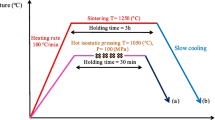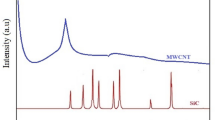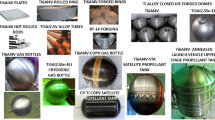Abstract
The authors have conducted a preliminary investigation with regard to the potential to manufacture porous titanium alloys for biomedical applications using toxic-free elemental powders, i.e., Ti, Nb, Ta, Zr, in combination with the pressurised gas bubble entrapment method and in contrast to standard processing routes that generally utilise prealloyed powder containing potentially toxic elements. Elemental powder compacts were either hot isostatic pressed (HIP-ed) at 1000°C and then foamed at 1150°C or else HIP-ed at 1100°C and foamed at 1350°C. Porous α + β alloys containing up to 45 vol% of porosity in the size range 20–200 μm were successfully produced, thus highlighting the potential of this manufacturing route. It was expected that further optimisation of the processing route would allow full development of the preferred β-Ti phase (from the point of view of elastic modulus compatibility between implant and bone) with this being the subject of future work by the authors.




Similar content being viewed by others
References
Niinomi M. Recent metallic materials for biomedical applications. Metall Mater Trans A. 2002;33:477–86.
Oh IH, Nomura N, Masahashi N, Hanada S. Mechanical properties of porous titanium compacts prepared by powder sintering. Scripta Mater. 2003;49:1197–202.
Hildebrand HF, Veron C, Martin P. Nickel, chromium, cobalt alloys and allergic reactions: an overview. Biomaterials. 1989;10:545–8.
Wapner KL. Implications of metallic corrosion in total knee arthroplasty. Clin Orthop Relat Res. 1991;271:12–20.
Eisenbarth E, Velten D, Muller M, Thull R, Breme J. Biocompatibility of β-stabilizing elements of titanium alloys. Biomaterials. 2004;25:5705–13.
Song Y, Xu D, Yang R, Li D, Wu WT, Guo ZX. Theoretical study of the effects of alloying elements on the strength and modulus of β-type bio-titanium alloys. Mater Sci Eng A. 1999;260:269–74.
Niinomi M. Mechanical properties of biomedical titanium alloys. Mater Sci Eng A. 1998;243:231–6.
Stojanovic D, Jokic B, Veljovic D, Petrovic R, Uskokovic PS, Janackovic D. Bioactive glass-apatite composite coating for titanium implant synthesized by electrophoretic deposition. J Eur Ceram Soc. 2007;27:1595–9.
Wilson J, Clegg RE, Leavesley DI, Pearcy MJ. Mediation of biomaterial-cell interactions by adsorbed proteins: a review. Tissue Eng. 2005;11:1–18.
Karageorgiou V, Kaplan D. Porosity of 3D biomaterial scaffolds and osteogenesis. Biomaterials. 2005;26(27):5474–91.
Jee CSY, Özgüven N, Guo ZX, Evans JRG. Preparation of high porosity metal foams. Metall Mater Trans B. 2000;31:1345–52.
Kearns MW, Blenkinsop PA, Barber AC, Farthing TW. Manufacture of a novel porous metal. Met Mater. 1987;3:85–8.
Davis NG, Teisen J, Schuh C, Dunand DC. Solid-state foaming of titanium by superplastic expansion of argon-filled pores. J Mater Res. 2001;16:1508–19.
Ashworth MA, Jacobs MH, Unwin P, Blunn G. In: 7th World Biomaterials Congress-2004, Sydney; 2004.
Oppenheimer S. Processing and Charaterization of Porous Ti–6Al–4V and NiTi. PhD Thesis, Northwestern University, IL; 2007.
Davis NG. Enhancement of solid state foaming of titanium by transformation superplasticity. PhD Thesis, Northwestern University, IL; 2002.
Taddei EB, Henriques VAR, Silva CRM, Cairo CAA. Production of new titanium alloy for orthopedic implants. Mater Sci Eng C. 2004;24:683–7.
Bobyn JD, Cameron H, Weatherly G. The optimum pore size for the fixation of porous-surfaced metal implants by the ingrowth of bone. Clin Orthop. 1980;150:263–70.
Hulbert S, Young F, Mathews R, Klawiter J, Takbert C, Stelling F. Potential of ceramic materials as permanently implantable skeletal prostheses. J Biomed Mater Res. 1970;4:433–56.
Acknowledgments
This study was supported financially by TPSDP, SPMU: Muhammadiyah University of Yogyakarta. The authors also wish to thank the Australian Nuclear Science and Technology Organisation (ANSTO) for carrying out the HIP-ing and foaming procedures. A part of this research was undertaken on the Powder Diffraction beamline at the Australian Synchrotron, Victoria, Australia.
Author information
Authors and Affiliations
Corresponding author
Rights and permissions
About this article
Cite this article
Nugroho, A.W., Leadbeater, G. & Davies, I.J. Processing of a porous titanium alloy from elemental powders using a solid state isothermal foaming technique. J Mater Sci: Mater Med 21, 3103–3107 (2010). https://doi.org/10.1007/s10856-010-4162-x
Received:
Accepted:
Published:
Issue Date:
DOI: https://doi.org/10.1007/s10856-010-4162-x




